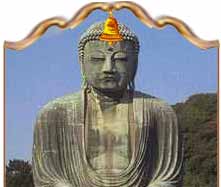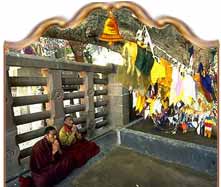Pilgrimage.Touristplacesinindia.com offers Pilgrimage Tours, Travel, Tourism, and Tour Packages for pilgrims of all religions. Get all the travel information and Travel services for Hindu Pilgrimages in India, Buddhist Pilgrimages in India, Sikh Pilgrimages in India, Christian Pilgrimages in India, and Jain Pilgrimages in India. Travel to the Holy Spots of India and get to know the most spiritual nation in the world
Pilgrimage Maps | Hotel Booking | Air Booking | Other Travel Services
| About Us |
Contact Us | Home
Buddhist Pilgrimages in India
BUDDHISM IN INDIA - AN INTRODUCTION

 Gautama, born in the sixth century BC, was the son of the ruler of the Sakya clan. His birthplace in the foothills of the Terai is known as Lumbini which is now a part of Nepal. From his early life, Gautama was intensely moved by the agony and suffering of living creatures such as a disabled old man or a wounded dog. His mind wanted to discover the cause of suffering and the way it may be overcome. He attained enlightenment in Bodhgaya under the Bodhi tree, some 10 kilometers from Gay in Bihar. The enlightenment came after his deep and prolonged meditation until body and mind became absolutely still and passed into the vessel of perfect tranquility. Thus he became a Buddha who had attained supreme understanding of the meaning of existence. After attaining enlightenment, legend has it that the Buddha remained seated for a week. This was the starting point of his formulation of the Buddhist faith and his preaching on how sorrow may be conquered through a lifestyle of great simplicity, renunciation and empathy for everything living.
Gautama, born in the sixth century BC, was the son of the ruler of the Sakya clan. His birthplace in the foothills of the Terai is known as Lumbini which is now a part of Nepal. From his early life, Gautama was intensely moved by the agony and suffering of living creatures such as a disabled old man or a wounded dog. His mind wanted to discover the cause of suffering and the way it may be overcome. He attained enlightenment in Bodhgaya under the Bodhi tree, some 10 kilometers from Gay in Bihar. The enlightenment came after his deep and prolonged meditation until body and mind became absolutely still and passed into the vessel of perfect tranquility. Thus he became a Buddha who had attained supreme understanding of the meaning of existence. After attaining enlightenment, legend has it that the Buddha remained seated for a week. This was the starting point of his formulation of the Buddhist faith and his preaching on how sorrow may be conquered through a lifestyle of great simplicity, renunciation and empathy for everything living.
BUDDHIST PILGRIMAGES IN INDIA
 Bodhgaya
Bodhgaya
Bodhgaya is reckoned as the most important Buddhist pilgrimage center. The magnificent Mahabodhi temple in Bodhgaya is an architectural amalgamation of many centuries, cultures and heritages of the devotees who pay their homage here. The temple bears the primary stamp of the architecture of the Gupta and subsequent ages. The temple carries inscriptions recording the visits of pilgrims from Sri Lanka, China, and Myanmar in the 7th and 10th centuries AD. Hiuen Tsang, the Chinese traveler also visited the temple in the 7th century.
More Information�
Vaishali
Vaishali has a special significance for the Buddhists. It is here that Buddha delivered his last sermon and announced his impending nirvana. Some of the pre-eminent events in his life occurred here such as the courtesan Amrapali giving him a mango orchard and becoming a Buddhist nun. The Buddha is supposed to have visited Vaishali three times. Centuries later, the Chinese travelers, Fa-Hien and Hiuen Tsang, followed the footsteps of the great Buddha. One hundred years after the Buddha's parinirvana 700 monks assembled from the north of India to discuss the ten points of Vinaya, the rule of conduct under dispute. Today, Vaishali is best known for the second Buddhist Council. Another historical importance attached to Vaishali lies in its being the capital of the ancient Lichhavis which is considered as the first republic of the world having an elected body of representatives and an efficient form of administration as far back as the 6th century BC.
More Information�
Nalanda
Some ninety kilometers south
of Patna stands Nalanda which means "the place that confers the lotus" in recognition of the attainment of spiritual knowledge. A monastic university was famous from the 5th to the 11th century. Hiuen Tsang was a student here in the seventh century and has written glowing accounts of the excellence of academic standards and the purity of monastic life of the inmates of the Nalanda University. This was the very first residential international university where on successful completion of the studies, the students were awarded a doctorate in Buddhist theology its practice. It contained nine million books, with 2,000 teachers to some 10,000 students who gathered here from all over the world. It is said that Lord Buddha himself taught here. The Gupta kings patronized the monasteries in Nalanda University which were built in the old Kushan style of architecture. Hiuen Tsang has left ecstatic descriptions of the ambience and architecture of this unique university of the ancient times. Ashoka and Harshavardhana were some of the most celebrated patrons who built temples and monasteries here. The ongoing excavations have uncovered a vast ensemble of monasteries, temples and lecture halls. In 1951, an international center for Buddhist studies was established in Nalanda.
Rajgir
Rajgir or Rajagriha which means "the Royal Place", lies 12 kilometers south of Patna. It was the ancient capital city of the Magadha kings. Rajgir is a site of great sanctity and significance for the Buddhists. The Buddha often visited Rajgir to retreat at the Jivkamaravana monastery located in a beautiful orchard. One of the most devoted and affluent followers of the Buddha, Jivaka who was a surgeon lived here. Many prosperous and well-to-do merchants and traders, who inhabited Rajgir became Buddha's devotees and raised many structures in the typical style of the Buddhist architecture. It was at Rajgir that the Buddha converted the Mauryan king Bimbisara, a famous follower of the Buddha, who further extended the Buddhist religion within and outside his kingdom. The Griddhkuta Hill, situated in Rajgir, was the seat wherefrom the Buddha delivered many of his sermons. Subsequent to the attainment of parinirvana by the Buddha, his followers congregated in a cave at Saptaparni in Rajgir to constitute the first Buddhist Council and hold a meeting. It was here that the teachings of the Buddha were reduced to writing for the first time.
Of late, the Japanese have built a stupa on top of Ratnagiri Hill which is linked with the surroundings by means of a ropeway. A sacrosanct structure at Rajgir of immense interest and importance consists of a sculpture which depicts the 'parinirvana' or the "Great Cessation" of the Buddha. It is a contemporary monument, which shows the Buddha lying on his right side with the right forearm resting under his head to commemorate the final salvation or 'mukti' of the great Founder of the Buddhist Faith. He spoke his last words before he slipped away from his earthly bonds forever. He said "Work out your own salvation with diligence".
Sarnath
Sarnath derives its name from Saranganatha (Lord of the Deer). After the Buddha attained enlightenment in Bodhgaya, he came to Sarnath. Here in the Deer Park, he delivered his first sermon or set in motion the Wheel of Law (Maha Dharmachakra Pravartan.). On the day before his death, the Buddha named Sarnath along with Lumbini, Bodh Gaya and Kushinagar as the four places that his followers should consider sacred. The Emperor Ashoka, who spread Lord Buddha's message of love and compassion throughout his vast empire, visited Sarnath around 234 BC and constructed a stupa here. Several Buddhist structures were built at Sarnath between the 3rd century BC and the 11th century AD and today this place has the most expansive ruins among the places related to the Buddha.
Explorations during a recent Japanese-funded UNESCO project have yielded this "biggest Buddhist settlement in all of Central India." The remains point to monasteries of enormous proportions. Earlier, eight structures had been identified. Now, 14 more monasteries and 23 stupas have been found. The Archeological Museum here as well as the Chinese and Tibetan Temples are all worth a visit.
More Information�
Kushinagar
Kushinagar is also known as Kasia or Kusinara. The founder of Buddhism, Lord Buddha passed away at this place near the Hiranyavati River and was cremated at the Ramabhar stupa. It was once a celebrated center of the Malla kingdom. Many of its stupas and viharas date back to 230 BC-AD 413, when its prosperity was at the peak. The Mauryan emperor Ashoka added grandeur to this place by getting the magnificent statue of Buddha carved on a single piece of red sandstone. Fa Hien, Huen Tsang, and I-tsing, the three famous Chinese scholar travelers to India, all visited Kushinagar.
With the decline of Buddhism, however, Kushinagar lost its importance and suffered much neglect. It was only in the last century that Lord Alexander Cunningham excavated many important remnants of the main site such as the Matha Kua and Ramabhar stupa. Today, people from all over the world visit Kushinagar. Many national and international societies and groups have established their centers here.
More Information
 |

